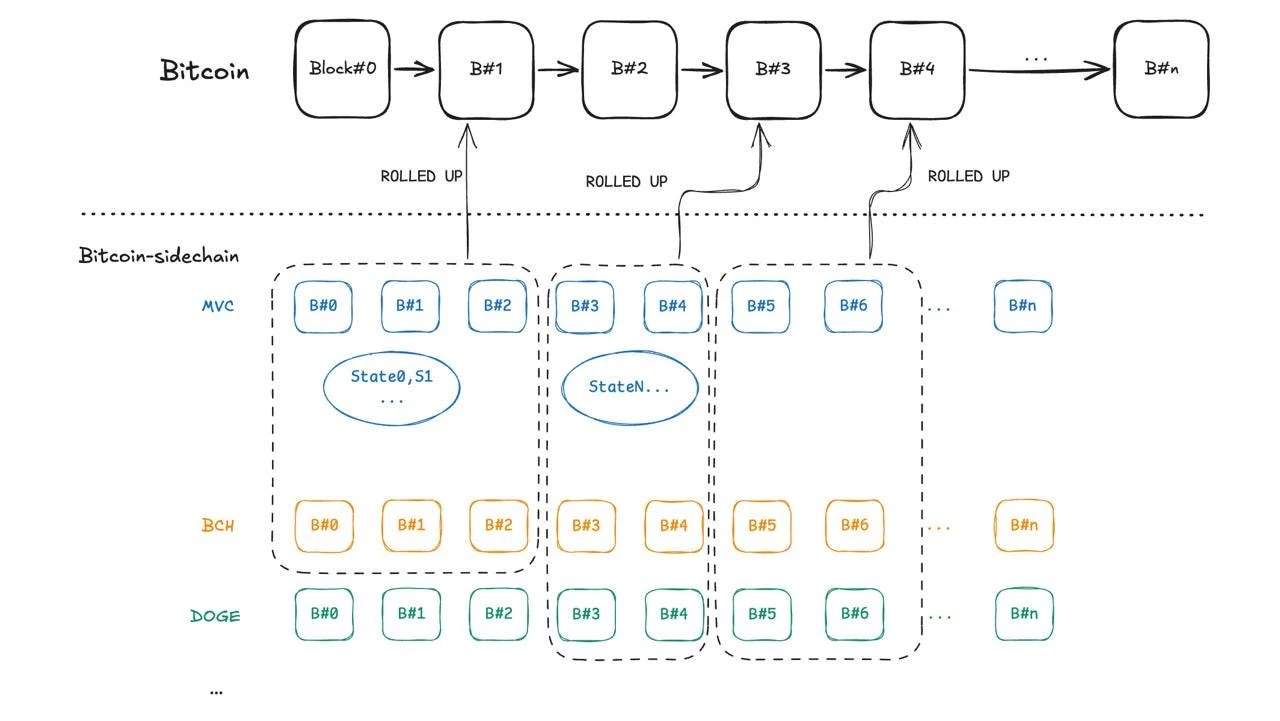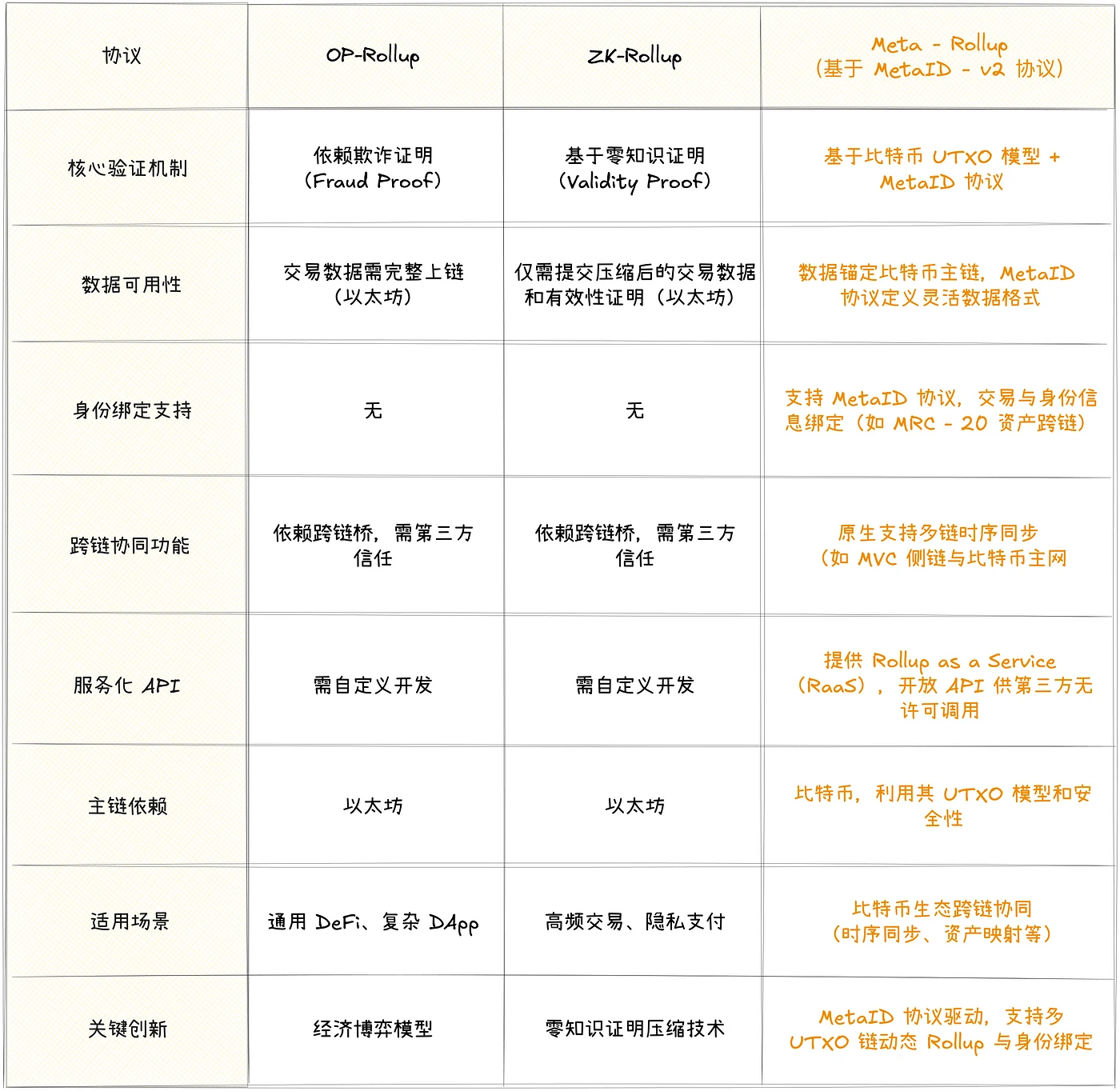
Meta-Rollup has officially launched as part of the MetaBitcoin Network plan, providing a new interaction mechanism and scalability between the Bitcoin mainnet and sidechains. The design of Meta-Rollup not only addresses the timing issues between Bitcoin and its sidechains but also establishes a unified data structure and infrastructure for cross-chain applications. Below is a technical introduction to Meta-Rollup, helping developers and tech enthusiasts better understand this innovation.
What is Meta-Rollup
Meta-Rollup is an efficient and scalable Rollup solution designed and implemented within the framework of the MetaBitcoin Network plan. Its core innovation lies in packaging key information from Bitcoin sidechains and other UTXO public chains (LTC, Doge, BCH, etc.), including transaction data and block information, into a standardized format and uploading it to the Bitcoin mainnet, thereby creating a tight integration and timing synchronization mechanism between the Bitcoin mainnet and sidechains. Specifically, Meta-Rollup uses Merkle hash technology to map sidechain transaction data to the Bitcoin mainnet, allowing the mainnet to effectively verify transactions on the sidechain without compromising the security, decentralization, and censorship resistance of the Bitcoin mainnet. This mechanism not only enhances the efficiency of cross-chain data transmission but also ensures interoperability and consistency between the mainnet and sidechains, optimizing the overall scalability and performance of the network.

Technical Challenges in Implementing Meta-Rollup
One of the main challenges faced by Meta-Rollup in technical implementation is the lack of prior references. The concept of Rollup is no longer new in the Ethereum network, but there are fundamental differences between the Bitcoin and Ethereum networks. Bitcoin uses a UTXO (Unspent Transaction Output) model, while Ethereum employs an account model, significantly increasing the complexity of cross-chain transactions and data verification. In Ethereum, Rollup can efficiently handle a large number of state updates and transaction verifications through smart contracts and virtual machines, whereas Bitcoin lacks similar functional support.
Therefore, Meta-Rollup must innovatively utilize Bitcoin's Merkle hash mechanism to map sidechain transaction data to the main chain while ensuring that the main chain can effectively verify the state and transactions of the sidechain. Another difficulty is the limitation of Bitcoin's block size; each block in the Bitcoin network has a relatively small capacity, which requires Meta-Rollup to optimize data compression and transmission efficiency to ensure that sidechain data can be effectively stored within the limited block space without imposing a significant burden on the mainnet's performance. Additionally, since the Bitcoin mainnet does not directly support high-frequency state updates and complex interaction logic, achieving fast and reliable Rollup operations without sacrificing Bitcoin's security and decentralization features has become a key challenge in technical development.
Timing synchronization is another critical technical difficulty that Meta-Rollup faces in the Bitcoin network. Given that the block time of the Bitcoin mainnet is approximately one block every 10 minutes, while the transaction processing speed on the sidechain is usually faster, ensuring data timing consistency between the Bitcoin mainnet and sidechains has become a significant challenge. Transactions on the sidechain must be mapped to the mainnet in a timely and accurate manner so that the mainnet can verify and confirm these transactions. If the timing is not synchronized, it may lead to delays in transaction verification or even data inconsistencies, affecting the reliability of the system. These challenges have been overcome by the team, thus truly realizing Meta-Rollup.

Why Choose Meta-Rollup?
The increasingly expanding Bitcoin ecosystem faces a growing challenge: various sidechains and UTXO public chains operate like "parallel universes," fighting their own battles, lacking a unified clock to order cross-chain interactions. This fragmentation poses risks to atomic swaps, asset bridging, and smart contract interoperability.
Meta-Rollup addresses this issue by establishing a shared time framework:
Block Sequence Alignment: Sidechain blocks are regularly hashed and submitted to the Bitcoin mainnet blocks, creating a verifiable timeline.
Merkle Cross-Chain Proofs: Cross-chain transactions are aggregated into a Merkle tree, with the root node stored in Bitcoin. This allows lightweight verification of cross-chain event order.
Decentralized Trust Anchoring: By inheriting Bitcoin's consensus security, sidechains gain tamper-proof timestamps without relying on centralized oracles.
This architecture lays the foundation for the vision of the MetaBitcoin network — a dynamically scalable UTXO chain network where Bitcoin serves as the backbone of time and cryptography.
Technological Innovations of Meta-Rollup
While the Rollup mechanism has matured in the Ethereum ecosystem, Meta-Rollup pioneers Bitcoin-centered innovations:
1. Multi-UTXO Chain Aggregation
Supports concurrent Rollup operations for multiple UTXO-based public chains (LTC, Doge, BCH, FB, etc.). Through a novel UTXO merging algorithm, transactions from different chains are batched into a single Bitcoin transaction, reducing on-chain footprint while maintaining atomicity.
2. Dynamic Block Interval Configuration
Rollup intervals can be programmed as divisors of 144 blocks (≈1 Bitcoin day). Chains can choose intervals (e.g., 24, 48 blocks) to balance cost and synchronization granularity. A penalty mechanism ensures that validators do not miss deadlines.
3. Rollup as a Service (RaaS)
Third parties can access Rollup proofs through a unified API (https://api.metabitcoin.network/api) without permission, including:
Time-ordered block headers
Cross-chain Merkle inclusion proofs
Authentication bound to MetaID
4. MetaID Integrated Data Model
Rollup data payloads follow the MetaID protocol, a flexible data container that supports:
Identity Binding: Associating Rollup data with decentralized identifiers (DIDs).
Schema Polymorphism: Encoding heterogeneous data types (e.g., asset mappings, smart contract logs) into a standard format.
Application Scenarios and Ecological Impact
Cross-Chain Time Ordering
Applications requiring strict cross-chain transaction ordering (e.g., decentralized exchanges, options contracts) can now resolve timing disputes by referencing Bitcoin's authoritative timeline.
Multi-Chain Asset Mapping
Meta-Rollup records the locking/unlocking events of cross-chain assets, supporting minimal trust bridging. For example, issuers of wrapped BTC on the sidechain can prove asset collateral through Merkle proofs anchored on Bitcoin.
Smart Contract State Finality
By submitting the hash of the execution results of sidechain smart contracts to Bitcoin, Meta-Rollup enables future Bitcoin Layer 2 networks to verify historical states without re-execution.
Paradigm Shift: From Chaos to Unity
Before Meta-Rollup, Bitcoin's sidechains existed in a "gray area" of time — operationally feasible but cryptographically disconnected. Meta-Rollup eliminates these boundaries, creating a unified cross-chain spatiotemporal framework where:
Each sidechain block has a provable position on the Bitcoin timeline.
Cross-chain transactions inherit Bitcoin's immutability.
Developers can build cross-chain dApps based on deterministic event order.
This is not just a technical upgrade; it redefines Bitcoin's role — transforming it from an independent ledger into the temporal root of a multi-chain universe.
Conclusion
The emergence of the MetaBitcoin Network and Meta-Rollup brings unprecedented cross-chain capabilities to Bitcoin, promoting multi-chain collaboration and the development of decentralized finance within the Bitcoin ecosystem. Through innovations in timing synchronization, asset mapping, and cross-chain smart contract execution, it addresses the technical bottlenecks between Bitcoin and sidechains, enabling the Bitcoin network to support more complex application scenarios while maintaining decentralization. With Meta-Rollup, Bitcoin is no longer an isolated digital asset but becomes the core hub of global decentralized finance and multi-chain ecosystems, moving towards a more open and interoperable future. This not only transforms Bitcoin from "digital gold" into a "programmable network" but also empowers numerous Bitcoin sidechains and UTXO networks with greater vitality.
免责声明:本文章仅代表作者个人观点,不代表本平台的立场和观点。本文章仅供信息分享,不构成对任何人的任何投资建议。用户与作者之间的任何争议,与本平台无关。如网页中刊载的文章或图片涉及侵权,请提供相关的权利证明和身份证明发送邮件到support@aicoin.com,本平台相关工作人员将会进行核查。




